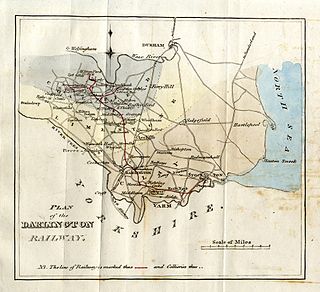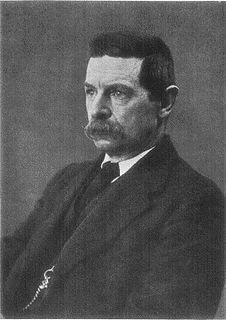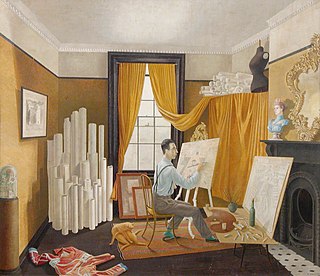
Francis Gibson (1805-1858), was a British banker and businessman.

Francis Gibson (1805-1858), was a British banker and businessman.
He was born in Saffron Walden, Essex, the son of the banker Atkinson Francis Gibson (1763-1829).

Saffron Walden is a market town in the Uttlesford district of Essex, England, 12 miles (19 km) north of Bishop's Stortford, 18 miles (29 km) south of Cambridge and 43 miles (69 km) north of London. It retains a rural appearance and some buildings of the medieval period. The 2001 parish population of 14,313 had risen to 15,504 by the 2011 census.
Atkinson Francis Gibson was a British banker.
Soon after his marriage, Gibson became a director of the Stockton and Darlington Railway. Soon afterwards, he was one of the four Quaker founders of Middlesbrough. [1]

The Stockton and Darlington Railway (S&DR) was a railway company that operated in north-east England from 1825 to 1863. The world's first public railway to use steam locomotives, its first line connected collieries near Shildon with Stockton-on-Tees and Darlington, and was officially opened on 27 September 1825. The movement of coal to ships rapidly became a lucrative business, and the line was soon extended to a new port and town at Middlesbrough. While coal waggons were hauled by steam locomotives from the start, passengers were carried in coaches drawn by horses until carriages hauled by steam locomotives were introduced in 1833.

Middlesbrough is a large post-industrial town on the south bank of the River Tees in North Yorkshire, northeast England, founded in 1830. The local council, a unitary authority, is Middlesbrough Borough Council. The 2011 Census recorded the borough's total resident population as 138,400 and the wider urban settlement with a population of 174,700, technically making Middlesbrough the largest urban subdivision in the ceremonial county of North Yorkshire. Middlesbrough is part of the larger built-up area of Teesside which had an overall population of 376,333 at the 2011 Census.
Although still base in Saffron Walden, Gibson and his wife spent two months every summer in County Durham and bought a house there, Balder Grange, in 1843. [1] The Victorian house is close to Cotherstone and overlooks the River Balder.

Cotherstone is a village and civil parish in the Pennine hills, in Teesdale, County Durham, England. Cotherstone lies within the historic county boundaries of the North Riding of Yorkshire, but along with the rest of the former Startforth Rural District it was transferred to County Durham for administrative and ceremonial purposes on 1 April 1974, under the provisions of the Local Government Act 1972.

The Balder is an English river that rises on the eastern slope of Stainmore Common in the Pennine Chain and flows eastwards for about 13 miles (21 km) to the River Tees at Cotherstone.
On 7 May 1829, he married Elizabeth Pease, the youngest daughter of Edward Pease, "the father of the railways". [1] He enjoyed painting and, late in life, he built the Fry Art Gallery (1856), in Saffron Walden. [2]
Edward Pease, a woollen manufacturer from Darlington, England, was the main promoter of the Stockton and Darlington Railway, which opened in 1825. He is sometimes referred to as the "Father of the Railways".

The Fry Art Gallery is an art gallery in Saffron Walden, Essex. Recognised as an Accredited Museum by Arts Council England, it displays work by artists of national significance who lived or worked in North West Essex during the twentieth century and after. The gallery is known for its comprehensive collection of work by the Great Bardfield Artists, including Edward Bawden and Eric Ravilious.
They had two children:

Lewis Fry was a Quaker, lawyer, philanthropist and a Liberal and later Liberal and Unionist politician who sat in the House of Commons in three spells between 1878 and 1900.
Apoplexy is bleeding within internal organs and the accompanying symptoms. For example, ovarian apoplexy is bleeding in the ovaries. The term formerly referred to what is now called a stroke; nowadays, health care professionals typically specify the type of apoplexy, such as cerebral, ovarian and pituitary apoplexy.

Edward Reynolds Pease was an English writer and a founding member of the Fabian Society.

Joseph Pease was a proponent and supporter of the earliest public railway system in the world and was the first Quaker permitted to take his seat in Parliament.

Edward Bawden, (1903–1989) was an English painter, illustrator and graphic artist, known for his prints, book covers, posters, and garden metalwork furniture. Bawden taught at the Royal College of Art, where he had been a student, worked as a commercial artist and served as a war artist in World War Two. He was a fine watercolour painter but worked in many different media. He illustrated several books and painted murals in both the 1930s and 1960s. He was admired by Edward Gorey, David Gentleman and other graphic artists, and his work and career is often associated with that of his contemporary Eric Ravilious.
The Pease family is an English and mostly Quaker family associated with Darlington, County Durham, and North Yorkshire, descended from Edward Pease of Darlington (1711–1785).
John Aldridge, was an accomplished oil painter, skilled draftsman, wallpaper designer, and esteemed art teacher in the United Kingdom. He was elected an Associate of the Royal Academy (ARA) in 1954 and a Royal Academician (RA) in 1963.
Stanley Clifford-Smith (1906–1968) was an English Expressionist painter and textile designer who was active as an artist in the 1940s, 1950s and 1960s.
Audrey Cruddas (1912–1979) was an English costume and scene designer, painter and potter.
Elizabeth Ayers, known as Duffy Ayers, was an English portrait painter. She was one of a pair of identical twin girls born to her American mother and Irish father, and has been known for most of her life by the nickname "Duffy".
Elizabeth Joan Glass (1915–2000), was an English textile designer and painter.
The Saffron Walden by-election, 1901 was a by-election held on 31 May 1901 for the British House of Commons constituency of Saffron Walden in Essex.
This Fry family was prominent in England, especially Bristol, in the Society of Friends, and in the confectionery business in the 18th, 19th, and early 20th centuries. They intermarried with many of the other prominent Quaker families and were involved in business and social and philanthropic causes. Although at their peak during the 19th century, the Fry family are still a very active family within England, specifically in Somerset.

Bridge End Gardens is a group of linked ornamental gardens in Saffron Walden, Essex, England. The gardens are listed Grade II* on the Register of Parks and Gardens. They are located off Castle Street, close to the Fry Art Gallery. Features include a maze.
Bernard Cheese was an English painter and printmaker, a fellow of the Royal Society of Painter-Printmakers. His works are found in internationally important collections in the UK and US.
George Stacey Gibson FLS, was a British banker, botanist and philanthropist.
Wyatt George Gibson was a British banker.
Walter Hoyle (1922–2000) was an English artist, known for his prints, watercolours and illustration. He was a central figure in the Great Bardfield group of artists and a close associate of Edward Bawden. He taught at the Central School, London, and, for twenty years, at the Cambridge School of Art.